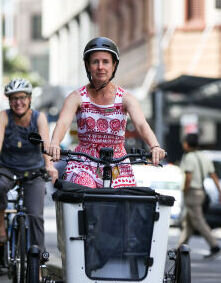Cycling infrastructure is becoming an economic imperative for local government areas and businesses in their district, according to long-serving bike advocate and the City of Sydney’s Manager of Cycling Strategy, Fiona Campbell.

Good public cycling infrastructure has become vital to attract people to live and work in an LGA – as well as enabling businesses to establish and grow in an area, she says.
Fiona will share her challenges and successes as a champion for cycling in local government when she addresses Australia’s first national micromobility conference in November.
She is part of a growing list of high-calibre speakers presenting at the Micromobility Conference at Sydney’s Randwick Racecourse on 25th and 26th November.
Equipped with many years’ experience as a leading cycling advocate, Fiona will share her ideas, lessons learnt and tips on successfully delivering cycling networks.
During her previous life as an experienced computer programmer, Fiona was an executive of Cycling Promotion Alliance, vice president of the Bicycle Federation of Australia, was a director on the Pedestrian Council of Australia board, wrote submissions for Bicycle NSW, and was a cycling representative on the Australian Bicycle Council and National Road Safety Strategy Panel. In 2019, she received a national leadership award at the Cycling Luminaries Awards, held by peak bicycle lobby organisation We Ride Australia.
Fiona joined the City of Sydney council in 2008, giving her an insider’s role in the development of local government cycling policy and the community engagement to support it.
Social and economic benefits
Fiona said local and State governments are increasingly recognising the social and economic benefits of providing effective and safe active transport infrastructure.
“Businesses want to locate their headquarters where it’s a nice place to live and easy to get around. For it to be easy to get around, you need to not have the whole place car dependent, you need public transport and easy access for walking for cycling,” she added.
“That makes it a place that attracts businesses.”
She said there is overwhelming community support for active transport infrastructure “because it makes so much sense. It’s not an ideological thing”.
City boosts commitment to active transport
City of Sydney is escalating its commitment to active transport infrastructure.
In recent years, it has been investing an average of $11 million but it is now well above that figure.
“Over the first 10 years, we built 15km of cycleways. Then in 2020, including the pop-ups, we did nine kilometres in the one year,” she said.
“Now we are going back and making some of those pop-ups permanent and really increasing the pace of projects. At the moment, we have five projects underway.”
They include separated cycleways in Pitt Street North, Kings Street, College Street, Erskineville and Alexandria.
Construction of a highly anticipated separated cycleway in the main arterial road of Oxford Street will start in about 12 months and will take just under a year to build.
Making it work
Fiona said while there is greater general support for active transport infrastructure, there are a number of measures councils and cycling advocate can take to increase the likelihood of projects going ahead.
There will inevitably be opponents to cycling projects and it is important to show decision makers the number of silent supporters.
“It’s really important to do either the doorknocking or a proper telephone survey that’s representative, or something so show decision makers the level of community support is actually much stronger than the impression they will get just from the letters they get,” she explained.
Fiona said councils could also benefit from having several projects in the planning stages.
“Stoke your pipeline because that’s what’s served us really well,” she said.
“In 2018, when we adopted the Cycling Strategy, the consultation we did for that showed great support among the community for the cycling strategy. But the number one comment we got was ‘you should do more, faster’.
“So during 2019, my colleague Beth did a huge amount of work looking at all the processes and procedures we have – the external ones seeking approval and the internal processes, how we do the procurement, materials and decision, what can we do to build more faster.
“As a result of that, we had more design concepts ready to be developed when COVID hit, and that’s what enabled us to take the opportunity with COVID.
“Since then, we’ve kept doing that, having lots of design projects in the pipeline, so we have projects ready to go. One of two of them will always hit a snag or delay, so that means we still have other projects we can continue with.”
Private Investment
She said businesses were also investing heavily to provide onsite end-of-trip facilities and capitalise on the trend towards active transport.
Over the past four years, businesses in the Sydney city centre have invested $57 million in end-of-trip facilities.
“That’s more than the State Government is investing in that area and its shows employers are keen to ensure their staff can take a healthy option to work,” she added.
She said they were building facilities in new buildings and retrofitting existing buildings, and “not because they had to, not because of council regulations”.





Leave a Reply